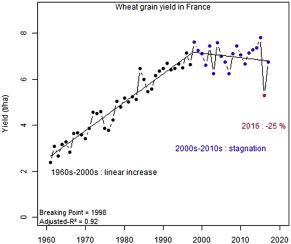当前位置:
X-MOL 学术
›
J. Cereal Sci.
›
论文详情
Our official English website, www.x-mol.net, welcomes your
feedback! (Note: you will need to create a separate account there.)
How changes in climate and agricultural practices influenced wheat production in Western Europe
Journal of Cereal Science ( IF 3.9 ) Pub Date : 2020-05-01 , DOI: 10.1016/j.jcs.2020.102960 Jacques Le Gouis , François-Xavier Oury , Gilles Charmet
Journal of Cereal Science ( IF 3.9 ) Pub Date : 2020-05-01 , DOI: 10.1016/j.jcs.2020.102960 Jacques Le Gouis , François-Xavier Oury , Gilles Charmet

|
Abstract Wheat is one of the main crops cultivated in nearly all regions of the world, from the equator to temperate lands. Since the early 1960s, grain yield has increased almost linearly. However, in several European countries, a stagnation is observed since the mid-1990s. Several studies have been carried out to analyse the possible causes of this stagnation, particularly in Western Europe and France. Three groups of factors are usually mentioned: a decrease in genetic progress, changes in agricultural practices for economic or regulatory reasons and, finally, more unfavourable biotic and abiotic environmental conditions. The vast majority of studies carried out in Europe and France show that the genetic progress has not slowed down since the 1980s. Among agricultural practices, a decrease in nitrogen fertilization and area of favourable preceding crops are often put forward. Finally, drought during the stem elongation and heat stress during grain-filling stages were mainly identified as environmental factors increasingly impacting yield. Besides average climate changes, extreme climatic years may have a large impact such as season 2015-2016 in France. Abnormally warm temperatures in late autumn, wet conditions and low solar radiations in spring explained this particularly low grain yield. Extreme events cause huge challenges to breeding that would require either adequate experimental conditions, trait assisted methods or genomic selection models that would enable to select for climatic scenarios that are very rare.
中文翻译:

气候和农业实践的变化如何影响西欧的小麦生产
摘要 小麦是世界上几乎所有地区(从赤道到温带地区)种植的主要作物之一。自 1960 年代初以来,粮食产量几乎呈线性增长。然而,在几个欧洲国家,自 1990 年代中期以来就出现了停滞。已经进行了几项研究来分析这种停滞的可能原因,特别是在西欧和法国。通常提到三组因素:遗传进展的减少、出于经济或监管原因的农业实践的变化,以及最后,更不利的生物和非生物环境条件。在欧洲和法国进行的绝大多数研究表明,自 1980 年代以来,遗传进展并未放缓。在农业实践中,人们经常提出减少施氮量和有利前作作物的面积。最后,茎伸长期间的干旱和籽粒灌浆期的热应激主要被确定为越来越影响产量的环境因素。除了平均气候变化之外,极端气候年份可能会产生很大的影响,例如法国的 2015-2016 季节。深秋异常温暖的气温、潮湿的条件和春季的低太阳辐射解释了这种特别低的粮食产量。极端事件给育种带来了巨大挑战,需要足够的实验条件、性状辅助方法或基因组选择模型来选择非常罕见的气候情景。茎伸长期间的干旱和籽粒灌浆期的热应激主要被确定为越来越影响产量的环境因素。除了平均气候变化外,极端气候年份可能会产生很大影响,例如法国的 2015-2016 季节。深秋异常温暖的气温、潮湿的条件和春季的低太阳辐射解释了这种特别低的粮食产量。极端事件给育种带来了巨大挑战,需要足够的实验条件、性状辅助方法或基因组选择模型来选择非常罕见的气候情景。茎伸长期间的干旱和籽粒灌浆期的热应激主要被确定为越来越影响产量的环境因素。除了平均气候变化之外,极端气候年份可能会产生很大的影响,例如法国的 2015-2016 季节。深秋异常温暖的气温、潮湿的条件和春季的低太阳辐射解释了这种特别低的粮食产量。极端事件给育种带来了巨大挑战,需要足够的实验条件、性状辅助方法或基因组选择模型来选择非常罕见的气候情景。深秋异常温暖的气温、潮湿的条件和春季的低太阳辐射解释了这种特别低的粮食产量。极端事件给育种带来了巨大挑战,需要足够的实验条件、性状辅助方法或基因组选择模型来选择非常罕见的气候情景。深秋异常温暖的气温、潮湿的条件和春季的低太阳辐射解释了这种特别低的粮食产量。极端事件给育种带来了巨大挑战,需要足够的实验条件、性状辅助方法或基因组选择模型来选择非常罕见的气候情景。
更新日期:2020-05-01
中文翻译:

气候和农业实践的变化如何影响西欧的小麦生产
摘要 小麦是世界上几乎所有地区(从赤道到温带地区)种植的主要作物之一。自 1960 年代初以来,粮食产量几乎呈线性增长。然而,在几个欧洲国家,自 1990 年代中期以来就出现了停滞。已经进行了几项研究来分析这种停滞的可能原因,特别是在西欧和法国。通常提到三组因素:遗传进展的减少、出于经济或监管原因的农业实践的变化,以及最后,更不利的生物和非生物环境条件。在欧洲和法国进行的绝大多数研究表明,自 1980 年代以来,遗传进展并未放缓。在农业实践中,人们经常提出减少施氮量和有利前作作物的面积。最后,茎伸长期间的干旱和籽粒灌浆期的热应激主要被确定为越来越影响产量的环境因素。除了平均气候变化之外,极端气候年份可能会产生很大的影响,例如法国的 2015-2016 季节。深秋异常温暖的气温、潮湿的条件和春季的低太阳辐射解释了这种特别低的粮食产量。极端事件给育种带来了巨大挑战,需要足够的实验条件、性状辅助方法或基因组选择模型来选择非常罕见的气候情景。茎伸长期间的干旱和籽粒灌浆期的热应激主要被确定为越来越影响产量的环境因素。除了平均气候变化外,极端气候年份可能会产生很大影响,例如法国的 2015-2016 季节。深秋异常温暖的气温、潮湿的条件和春季的低太阳辐射解释了这种特别低的粮食产量。极端事件给育种带来了巨大挑战,需要足够的实验条件、性状辅助方法或基因组选择模型来选择非常罕见的气候情景。茎伸长期间的干旱和籽粒灌浆期的热应激主要被确定为越来越影响产量的环境因素。除了平均气候变化之外,极端气候年份可能会产生很大的影响,例如法国的 2015-2016 季节。深秋异常温暖的气温、潮湿的条件和春季的低太阳辐射解释了这种特别低的粮食产量。极端事件给育种带来了巨大挑战,需要足够的实验条件、性状辅助方法或基因组选择模型来选择非常罕见的气候情景。深秋异常温暖的气温、潮湿的条件和春季的低太阳辐射解释了这种特别低的粮食产量。极端事件给育种带来了巨大挑战,需要足够的实验条件、性状辅助方法或基因组选择模型来选择非常罕见的气候情景。深秋异常温暖的气温、潮湿的条件和春季的低太阳辐射解释了这种特别低的粮食产量。极端事件给育种带来了巨大挑战,需要足够的实验条件、性状辅助方法或基因组选择模型来选择非常罕见的气候情景。









































 京公网安备 11010802027423号
京公网安备 11010802027423号